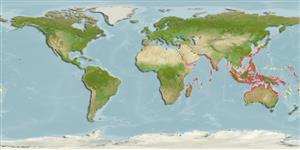Environment: milieu / climate zone / depth range / distribution range
Ecología
marino asociado a arrecife; no migratorio; rango de profundidad 1 - 15 m (Ref. 90102). Tropical; 22°C - 27°C (Ref. 130643)
Distribución
Países | Áreas FAO | Ecosistemas | Ocurrencias, apariciones | Point map | Introducciones | Faunafri
Indo-West Pacific: Red Sea and southern Oman south to Natal, South Africa and east to the western Pacific where it occurs from Japan to northern Australia.
Tamaño / Peso / Age
Maturity: Lm ? range ? - ? cm
Max length : 9.0 cm TL macho / no sexado; (Ref. 4329)
Espinas dorsales (total) : 8; Radios blandos dorsales (total) : 9; Espinas anales: 2; Radios blandos anales: 8. Characterized by having dorsal fin rays VII-I, 9; anal fin rays II,8; pectoral fin rays 16; pelvic fin rays I, 5; pored lateral line scales 23-24; predorsal scales 3; circumpeduncular scales 12 (Ref. 93839); coppery brown to yellowish with an oblique black line below eye; may have three faint, dusky bars on sides (Ref. 2334, 48635); characterized further by the following: irregular whitish bar across anterior caudal peduncle; lower gill cover with dark brown patch; narrow, oblique dark band below eye; yellowish fins; first dorsal fin with dark brown tip; greatest depth of body 2.5-2.8 in SL (Ref. 90102).
Found in shallow protected coastal reef crests and lagoons, hiding below corals during the day, but also trawled on soft bottom (Ref. 48635); also under boulders on shallow reef flats. Nocturnal species. Aquarium breeding is possible (Ref. 130643).
Life cycle and mating behavior
Madurez | Reproducción | Puesta | Huevos | Fecundidad | Larva
Mouthbrooders (Ref. 240). Distinct pairing during courtship and spawning (Ref. 205).
Randall, J.E., G.R. Allen and R.C. Steene, 1990. Fishes of the Great Barrier Reef and Coral Sea. University of Hawaii Press, Honolulu, Hawaii. 506 p. (Ref. 2334)
IUCN Red List Status (Ref. 130435: Version 2024-1)
Threat to humans
Harmless
Human uses
Pesquerías: comercial; Acuario: Comercial
Herramientas
Special reports
Download XML
Fuentes de Internet
Estimates based on models
Preferred temperature (Ref.
123201): 24.6 - 29.3, mean 28.3 °C (based on 2805 cells).
Phylogenetic diversity index (Ref.
82804): PD
50 = 0.5000 [Uniqueness, from 0.5 = low to 2.0 = high].
Bayesian length-weight: a=0.01778 (0.00980 - 0.03226), b=3.16 (3.00 - 3.32), in cm total length, based on LWR estimates for this species & (Sub)family-body (Ref.
93245).
Nivel trófico (Ref.
69278): 3.4 ±0.5 se; based on size and trophs of closest relatives
Resiliencia (Ref.
120179): Alto, población duplicada en un tiempo mínimo inferior a 15 meses (Preliminary K or Fecundity.).
Fishing Vulnerability (Ref.
59153): Low vulnerability (10 of 100).
Nutrients (Ref.
124155): Calcium = 163 [80, 279] mg/100g; Iron = 1.06 [0.59, 1.88] mg/100g; Protein = 18.6 [17.4, 19.8] %; Omega3 = 0.12 [0.06, 0.23] g/100g; Selenium = 28.7 [13.7, 58.7] μg/100g; VitaminA = 58.5 [16.7, 209.3] μg/100g; Zinc = 1.89 [1.20, 2.89] mg/100g (wet weight);
